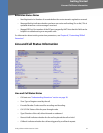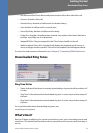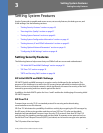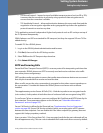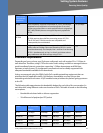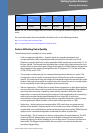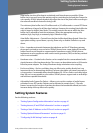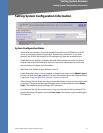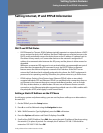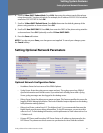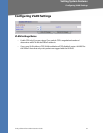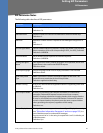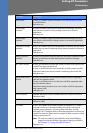
Linksys SPA9x2 Phone Administration Guide 40
Setting System Features
Setting System Features
Jitter buffer size should be kept to a relatively small size whenever possible. If jitter
buffer size is too small, many late packets may be considered as lost and thus lowers the
voice quality. SPA9x2 phones dynamically adjust the size of the jitter buffer according to
the network conditions that exist during a call.
The minimum jitter buffer size is 30 milliseconds or (10 milliseconds + current RTP frame
size), whichever is larger, for all jitter level settings. However, the starting jitter buffer size
value is larger for higher jitter levels. This setting controls the rate at which the jitter
buffer size is adjusted to reach the minimum. Select the appropriate setting: low,
medium, high, very high, or extremely high. Defaults to high.
Jitter Buffer Adjustment—Controls how the jitter buffer should be adjusted. Select the
appropriate setting: up and down, up only, down only, or disable. Defaults to up and
down.
• Echo—Impedance mismatch between the telephone and the IP Telephony gateway
phone port can lead to near-end echo. SPA9x2 phones have a near-end echo canceller
with at least 8 ms tail length to compensate for impedance match. SPA9x2 phones
implement an echo suppressor with comfort noise generator (CNG) so that any residual
echo is not noticeable.
• Hardware noise—Certain levels of noise can be coupled into the conversational audio
signals because of the hardware design. The source can be ambient noise or 60 Hz noise
from the power adaptor. The Linksys hardware design minimizes noise coupling.
• End-to-end delay—End-to-end delay does not affect voice quality directly but is an
important factor in determining whether IP phone subscribers can interact normally in
a conversation. A reasonable delay should be about 50–100 ms. End-to-end delay larger
than 300 ms is unacceptable to most callers. SPA9x2 phones support end-to-end delays
well within acceptable thresholds.
• Adjustable Audio Frames Per Packet—Allows you to set the number of audio frames
contained in one RTP packet. Packets can be adjusted to contain from 1–10 audio
frames. Increasing the number of packets decreases the bandwidth utilized, but it also
increases delay and may affect voice quality.
Setting System Features
See the following sections:
• ”Setting System Configuration Information” section on page 41
• ”Setting Internet, IP and PPPoE Information” section on page 42
• ”Setting a Static IP Address on the IP Phone” section on page 42
• ”Setting Optional Network Parameters” section on page 43
• ”Configuring VLAN Settings” section on page 44



